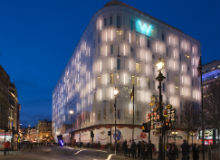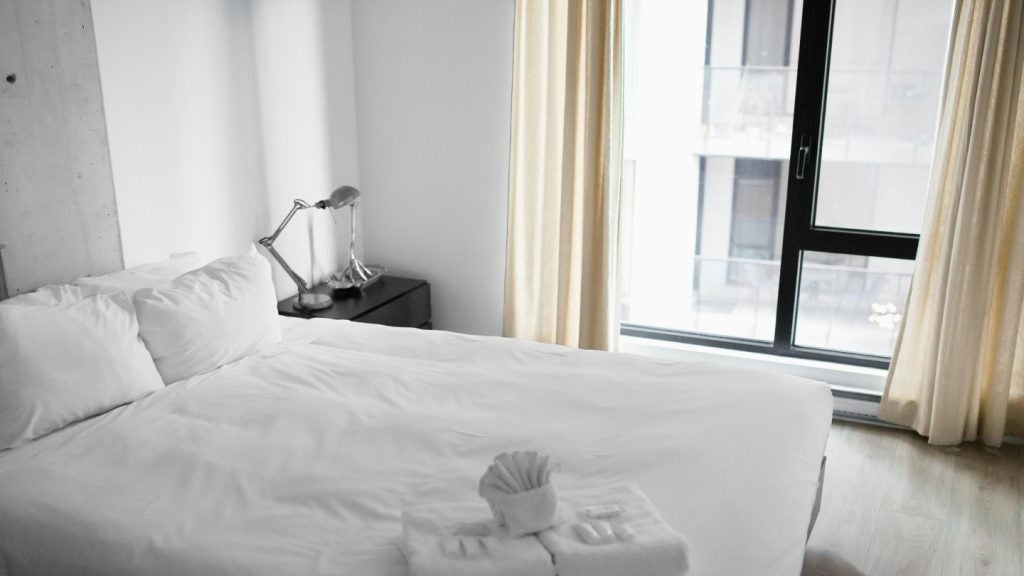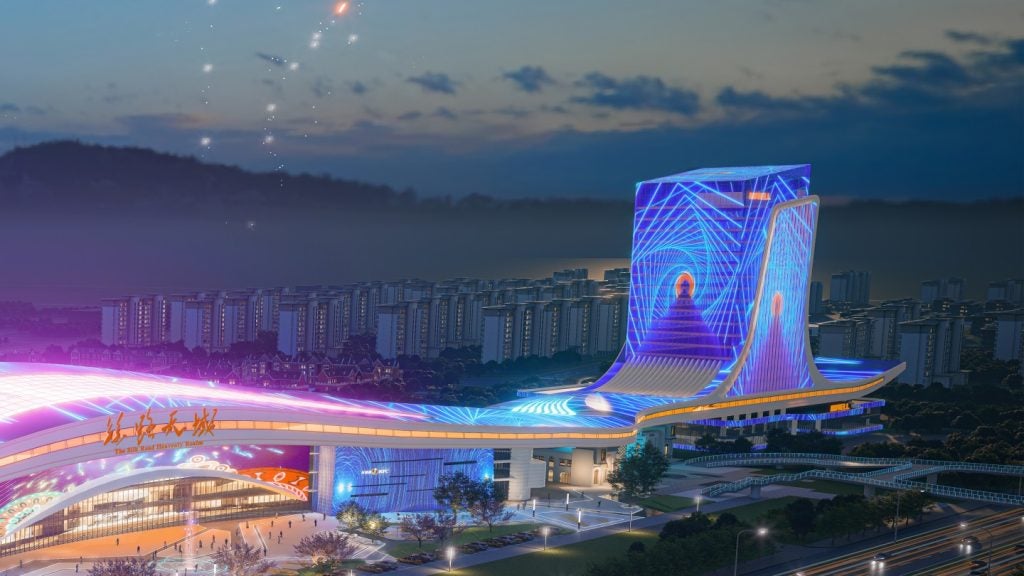
The old cliché of a hotel as a ‘home away from home’ is apt to polarise those who stay there. On the one hand, plush carpets, plentiful amenities and a smiling concierge may make for a pleasant experience; a taste of domesticity in an otherwise unfamiliar location. On the other hand, comfort with no character can all too easily blur into dreariness.
"Something like your home is just mundane," says James Dilley, associate director at architecture and interior design firm Jestico + Whiles. "Why would you want that, if you had a choice? You’d want something special."
John Whiles, a founding director at the firm, agrees. I am sitting in a meeting room with the two of them, in their slick offices just off London’s Euston. Guided by a slideshow, they are running me through their not unsubstantial portfolio.
The present slide shows the Andel’s Hotel Lodz in Poland, a former textile mill, which reached completion in 2009. This is a witty, striking, art-glutted storybook of a hotel, simultaneously honouring its industrial origins and embedding itself in Polish culture.
We are looking at the swimming pool, which began life as a water storage tank on the roof. Lucent and ethereal, with music playing underwater, the pool is surrounded by transparent glass-panelled flooring. Beneath you is a sheer drop of seven storeys, allowing a straight view down to the city below.
"Hotels to us are not a home from home," says Whiles, emphatically. "You don’t want to go, ‘oh thank God, it feels just like home’. This is something to experience."
How well do you really know your competitors?
Access the most comprehensive Company Profiles on the market, powered by GlobalData. Save hours of research. Gain competitive edge.

Thank you!
Your download email will arrive shortly
Not ready to buy yet? Download a free sample
We are confident about the unique quality of our Company Profiles. However, we want you to make the most beneficial decision for your business, so we offer a free sample that you can download by submitting the below form
By GlobalDataA diverse portfolio
Jestico + Whiles was founded in 1977 by Whiles and fellow architect Tom Jestico. It has since grown dramatically, with a second office in Prague to complement this one, a plethora of awards to its credit, and commissions across the world. The firm’s expertise spans many sectors – universities, schools, housing, cultural facilities, offices, transport infrastructures and retail among others.
Hotels have been a particular passion for 15 years, starting in a purely architectural capacity and then moving on to interiors. The company’s first commission was Anoushka Hempel’s Hempel Hotel in Bayswater, followed by the much-hyped One Aldwych and several Malmaisons.
Since then, their success has snowballed, encompassing the Dead Sea Spa Hotel in Jordan, the Red & Blue Design Hotel in Prague, a number of Hiltons and the iconic Yas Hotel in Abu Dhabi, just off the F1 Grand Prix race track. Most recently, two new builds in London have opened just in time for the Olympics.
It’s a diverse portfolio, without much in the way of visual continuity – these hotels draw far more upon contextual factors than signature design motifs. "We don’t have a house style we stamp onto everything so that all our buildings look the same," says Dilley. "There are some hotel designers who do do that, and that’s why they’re employed, but we don’t take a generic approach; we make hotels specific to each and every opportunity that we have."
Nonetheless, certain key tenets resound throughout their output, one of these being humour. In the Hotel Lodz, the conference breakout area contains seats that look like sweets; commodious confectionary pieced together from scraps of fabric. Meanwhile, in the Malmaison Oxford, the settees are covered with prisoners’ uniforms, a characterful nod to the building’s past as a jail.
"I think people go into these buildings and smile," says Whiles. "Something’s happening there that they would not expect."
The hotel as theatre
The designs are also enjoyably theatrical. Eschewing the idea of a hotel as merely somewhere private to recoup, Jestico + Whiles wishes to catch the eye. Intimacy is supplemented with entertainment, snugness with spectacle, and closed-off corridors with an expansive, public-oriented ethos.
One need only think of One Aldwych, which is often cited as a pioneer of so-called ‘lobby culture’. Rather than curtaining itself away from the world, as is the case with so many other luxury hotels in London, the hotel lobby is reappraised as a social hub.
Busy, lively and rousingly urban, this property is set on a triangular site at the juncture of Aldwych and the Strand. The double-height lobby bar, which features windows all the way around two sides, is clearly visible to passersby and as such is designed to lure them in. Meanwhile, hotel guests, enticed by the buzz, are naturally drawn out of their suites.
It goes without saying that One Aldwych is monumentally elegant, attracting visitors not just because of its openness but as a result of its arresting design. One of the world’s leading five-star boutiques, this project took shape in close collaboration with the interior designer Mary Fox Linton, and mixes the building’s existing Edwardian features with slickly minimalistic contemporary touches.
Original sculptures are complemented by vast flower arrangements, sleek lines and a polished limestone floor. Insofar as visual dazzle is often low down a hotel’s agenda, Jestico + Whiles redresses a recent trend.
"Over the last 15-20 years, hotels have lost some glamour," laments Dilley. "In the 70s, going to a Hilton was the epitome of luxury and class, but hotels have been allowed to slip into a kind of mediocrity. It doesn’t need to be that way. You don’t need to spend more money to make something an icon."
Aloft ExCel, which opened in December, is exemplary in this regard: an unusually striking building created within tight financial, stylistic and spatial constraints. Situated in London’s Docklands, and directly connected to the ExCel Centre, the hotel was built in a serpentine shape so as not to encroach on the dockside. It stands in sharp contrast to the two hotels across the car park, which might best be dubbed lacklustre.
The building’s central plane is made from glass and its two external wings in a specially treated, light-reflective stainless steel. Dappled with an undulating skyscape of purples, pinks, blues and greys, Aloft is designed to remain long in the memory, leaving adjacent buildings in the shade.
Interior dialogue
Jestico + Whiles was responsible for the interiors as well as the architecture, which meant abiding by the brand’s existing style guide. Created by the architect David Rockwell, it was in many regards quite prescriptive.
Nonetheless, there was room for interpretation. "We absorbed the brand book from Starwood, and developed it, tuning it towards a better performance," says Whiles. "Because the Aloft brand had been evolved in the US, the standards that they had did not necessarily work with European regulations, so we had to change everything."
Thus, while there are two windows in each room, and Aloft’s basic colour palette of burgundy and green, other particulars are very much the firm’s own. The swimming pool, for example, vetoes the generic Mediterranean approach of turquoise tiles and beige ceramics, instead referencing the building’s exterior. And where there is a disjuncture between two levels, this is celebrated with a prominent sculptural element. As Jestico + Whiles sees it, distinctiveness translates directly into higher occupancy rates.
In any event, whatever the eventual pay-off for Starwood, the strategy has proven lucrative for the designers. On seeing Aloft, several clients approached the firm and requested similarly landmark hotels for their own cities.
As a result, Jestico + Whiles is gaining an enviable global reputation, both for its responsiveness to requirements, and its willingness to try something new. One particularly challenging commission was W London, which opened its doors last year. Here, the hurdles were twofold: providing a stylish, standout building for Starwood, while placating the conservatism of the local authority planners.
The property was to sit across three conservation areas, and so needed to reflect local traditions without caving in to fustiness. Jestico + Whiles had to channel the vibrancy of Soho, the theatre of Leicester Square and the Edwardian formality of Haymarket, all within the context of a young and elite brand.
They responded by applying the high design treatment. Because planning laws required active frontages at street level, the hotel itself does not start until the first floor, meaning the entrance works as a kind of stage, and the lights and glamour of the elevated reception spill out onto the bustling streets below.
Moreover, as with Aloft, ‘reflecting the context’ took a very literal slant. Translucent glass was suspended from the façade, mirroring the surrounding hubbub. A cacophony of colour is visible by day; an internally illuminated veil of light by night.
"London’s a very difficult place to build if you don’t take the route of pastiche," says Dilley. "We’ve been very sensitive and gentle on this one, but also quite brave, because nobody’s done anything like this in this location. Especially with the Olympics coming up, and this forming part of the Olympic route, it’s good to have something Westminster can be proud of in a global context."
Designs on expansion
Global context is key for Jestico + Whiles, with new projects slated for numerous locations worldwide. The day of our interview, John Whiles is gearing up for a meeting about an arts centre in Sri Lanka, and has just taken a call about a large retail outlet in Milan.
A few weeks later, he will head to Cuba, to discuss the prospect of developing a nanotechnology laboratory there. James Dilley, meanwhile, is working on the off-site construction of West African modular hotels.
Both say that the travel is enlivening, adding extra character and flavour to their practice. Whiles remarks he did not expect this level of growth or success when he started out, but he concedes that sheer grit might have had a role to play – this is a trust, so the staff have a personal incentive to put their all in. Everyone, he says, works "bloody hard".
In many senses, a hotel is like any other kind of project for Jestico + Whiles. Whatever the building, it’s all about the journey: the emotions that are elicited from the moment you pull up in the taxi, to the point at which you leave. It’s also about understatement, the synthesis of art and science so as to fulfil technical requirements in imaginative, yet unobtrusive ways.
If hotels do have something extra to contribute, then that may come in the form of their sheer diversity. Ranging from Hotel Villa Honegg, a private property on top of a Swiss mountain, to Allegria Resort in Cairo, Jestico + Whiles has it covered: new builds and renovations, private clients and global operators alike.
"That hotel in the mill factory, it was a once in a lifetime opportunity," considers Dilley, reverting to the Andel’s Hotel Lodz. "But we’ve been lucky enough to get a lot of once in a lifetime opportunities back to back. As a design practice, you can’t really ask for much more than that."






